At 12:30 PM on 22 November 1963, Lee
Harvey Oswald was standing in the doorway of the Texas School Book
Depository watching the Presidential motorcade, and he was captured on
film by James "Ike" Altgens of the Associated Press. Although the issue
has been disputed for decades, there is now abundant and compelling
evidence which proves --beyond all reasonable doubt -- that Lee was the
"Man in the Doorway" in the famous Altgens photo (seen below), where he
is standing next to the white column on the left.

The area within the red rectangle in the image above is enlarged below.

Notice first that Doorman was wearing a long-sleeved, loose-fitting outer shirt, which was substantially unbuttoned and sprawled open, beneath which he wore a white t-shirt. The neck of this t-shirt was stretched because of his habit of tugging on it and thereby forming a pseudo-V. It wasn't manufactured as a V-neck t-shirt, but it became one from Lee pulling on it.
Those who were managing the photographic record in Dealey Plaza that day were alarmed that Lee was present in the photograph, and they took measures to alter his appearance by moving some of the features of Billy Lovelady, his co-worker, to Lee. However, the clothing is the key to unmasking the deception. Unless Billy attacked Lee in the Men's room, or elsewhere, and stole his clothes, it must have been Lee in the doorway. No one could be wearing Lee's clothing except Lee. We'll be looking at this much closer and in great detail, and you will see very clearly how it was done.
It is important to realize that Doorman's image consists of 80% clothing. And therefore, a close examination of his clothing is paramount in determining his identity. That should have been obvious from the beginning, yet it was repeatedly ignored. There is not a single word in The Warren Report (1964) about Doorman's clothing. And when the House Select Committee on Assassinations considered this in 1977-78, they focused mostly on Doorman's face, comparing it to Oswald's and Lovelady's.
They even hired a team of anthropologists to make some extremely fine and minute anthropometric measurements: such as the distance between the eyes, the shape of the chin, the bulbous-ness of the nose, etc. That some of Lovelady's facial features were moved to Doorman, replacing Lee's, is something that the HSCA never considered, although there is compelling evidence to support it.
Oswald's whole outfit was very unusual, actually unique, and we can see it on Doorman: conspicuously. But before we proceed with that analysis, which will consist mostly of picture collages so that you can compare the evidence with your own eyes, please make note of two important points:
(1) Establishing that Lee Harvey Oswald was the Doorman in the Altgens photo, by itself, completely and thoroughly exonerates him. If he was standing in the doorway at the time of the shooting, he could not possibly have been at the same time up on the 6th floor firing at President Kennedy. This one determination is therefore enough, by itself, to settle the matter once and for all. No one can be in two places at the same time. And we shall provide ample proof that Oswald was in the doorway.
(2) This is a default situation. There are only two possibilities for Doorman's identity, even theoretically, and they are Lee Harvey Oswald and Billy Nolan Lovelady, who was another TSBD worker. Nobody is suggesting that it may have been a third person, perhaps an anonymous stranger who was walking by. All of the individuals standing on the steps were TSBD employees, and the only one who had the remotest resemblance to Oswald was Billy Lovelady.
And keep in mind that their similarities have been greatly exaggerated--they really didn't look that much alike. How could they when one weighed 170 pounds or more (Billy) and the other weighed 131 pounds (Lee), making a 40 pound weight difference between them. We'll have more to say about that later.
Our approach is going to be to establish the likeness of Oswald and Doorman on the one hand, and the unlikeness (the stark dissimilarity) of Lovelady and Doorman on the other. Since there are only two candidates for Doorman, evidence that rules out Lovelady as Doorman automatically supports Oswald. So, Lee wins by default just by proving that Billy could not be Doorman.
Then, we lay out our catalog of Altgens anomalies--proof of alteration--which shows you exactly what they did and how they did it. Then, we provide resources for further reading about this and other areas of JFK assassination research.
Finally, our Wrap page is where we wrap things up, but it is also meant to be an ongoing blog. These are short pieces, distinguished by author and date, including timely announcements by Ralph Cinque, as needed. The lead article is a synopsis of the chapter "The "Man in the Doorway" by Dr. David Wrone from his book: The Zapruder Film: Reframing the JFK Assassination.
As the 50th anniversary of the JFK assassination has come and gone, it is time to dispel, once and for all, the official myth--the official lie!--that Lee Harvey Oswald murdered President Kennedy. He did not and could not have done it. None of us can be in two places at the same time. The lone assassin was actually standing in the doorway when the murder took place. And, it is not a close call. Distinctly and conspicuously, Lee Oswald can be seen outside as the massacre was underway. Lee Harvey Oswald was not guilty of this monstrous crime. Now, a few words from Professor James Fetzer:
Reasoning about Doorman
“When you
have eliminated the impossible, whatever remains, no matter how
improbable, must be the truth”. – Sherlock Holmes (A. Conan Doyle)
by James H. Fetzer
1 August 2012
Since
there appears to be considerable confusion about reasoning
scientifically in a case of this kind, perhaps the most valuable
contribution I can make to the discussion of Doorman and Oswald concerns
the pattern of reasoning that applies here. Having
offered courses in logic, critical thinking and scientific reasoning to
college students for 35 years, I am well positioned to explain the
principles that apply in cases of this kind, which are part and parcel
of the application of the scientific method.
The scientific method is a process involving four steps or stages of investigation or inquiry, beginning with PUZZLEMENT, where some phenomenon or event does not fit into your background knowledge and understanding; SPECULATION, where the full range of appropriate alternative explanations are advanced; ADAPTATION, where those alternatives are tested relative to the available evidence; and finally, EXPLANATION, where the alternative that is best supported is acceptable as true but in the tentative and fallible fashion of science--and additional research can confirm or disconfirm it.
Scientific Reasoning
The key stage is ADAPTATION, which involves the application of inference to the best explanation to the available evidence. This
requires comparing the relative degrees of evidential support for
alternative hypotheses by calculating the probability of the data on the
assumption that the hypothesis is true. Do that for each of them and see which of them confers the highest probability on the evidence, if it were true. It sounds like a process of reasoning backwards and, in a way, it is: you
are treating the evidence as the effect of a cause and comparing the
probability with which various causes could have brought about an
effect. If you found a tree
that had been cut in half and felled, what is the probability that that
had been done with a pen-knife, a Swiss Army knife or a chain saw? Consider the effects and figure out which among its possible causes is most likely.
An hypothesis with a higher likelihood is preferable to one with lower, where the one with the highest likelihood is acceptable as true when the evidence has “settled down”. It is always possible to return to make a recalculation when new evidence or new alternatives become available. Here
I want to highlight a few of the key considerations that have led me to
conclude that Doorman and Oswald are indeed one and the same man,
where, in this case, we are essentially dealing with only two
alternatives, namely: that
Doorman was Billy Lovelady, as the government contends, or that Doorman
was Lee Oswald, as David Wrone, Ralph Cinque, Richard Hooke, Orlando
Martin and I – among others – contend. Because
there are only two serious candidates, evidence that favors one of them
disfavors the other, and evidence that disfavors one of them favors the
other. Doorman is one or the other.
“Out with Bill Shelley in front”

Some have claimed Lee was not talking about his location during the shooting but some time thereafter. But, that makes no sense at all since we know Lee was observed on and around the first floor at 11:50 AM, Noon, and 12:15 PM. The latter was reported by Carolyn Arnold on November 25 when she was interviewed by the FBI. She said she believed she saw Oswald between the double doors (which means, at the doorway) at 12:15. Professor Gerald McKnight has suggested that it is likely that the FBI agent proffered the time of 12:15 in order to leave Oswald enough time to hustle up to the 6th floor. But others, smarter than FBI Agent Richard Emberling, realized that it was still a disaster for Oswald to be lingering on the first floor at 12:15. So, what happened is that the Gestapo returned to the TSBD in March 1964, and they got Carolyn Arnold to sign a statement saying that she didn't see Oswald at all. And then, they changed the time that she got outside to the accurate one: 12:25. And although Carolyn Arnold never testified to the Warren Commission, her November 25, 1963 FBI statement is one of the most damning statements to JFK Officialdom. Carolyn Arnold was a witness to Oswald at the doorway, but, this 19 year old didn't realize on November 25 that it wasn't OK to say it.
So, Oswald could not have been referring to being outside with Bill Shelly before the motorcade because the record shows that Shelley was one of the first outside while Oswald had not yet breached the glass door to go outside as late as 12:25. We presume that Oswald stepped outside right after Carolyn Arnold saw him at 12:25. But, that was the time of the motorcade, essentially. Within 90 seconds, after the shooting, Oswald had been accosted in the lunchroom by Roy Truly and motorcycle officer Marion Baker. Oswald could not have meant he was "out with Bill Shelly in front" after the shooting because Bill Shelly was not out there then. Shelly said he left immediately, with Billy Lovelady, to walk over to the railroad tracks to look around. That was before Truly and Baker even entered the building. And when Lovelady and Shelly returned, they re-entered the building through the backdoor of the TSBD, and went to the base of the back stairwell in the northwest corner (rear) of the building. So, Bill Shelly was definitely not out in front when Oswald was leaving for home.
The notion that "out with Bill Shelley in front" is a reference to after the assassination when Oswald was leaving for home is really stupid. We are dealing here with the murder of the President of the United States, so what difference does it make who Oswald saw when he was leaving for home? Why would he need an alibi for that? Does anybody doubt that he went home? Why would Fritz say, "Lee, we want to know who you saw when you left for home because unless we get a confirmation, we're going to have to assume that you just stayed in the building." And then what? Did Oswald say, "No, I really did leave for home. You've got to believe me. Just ask Bill Shelley- he'll tell you." The point is that, just as there are no chin shadows that look anything like the vee we see on Doorman, which makes the whole shadow claim preposterous, likewise, the probative value of knowing who Oswald saw when he left for home is so useless that it is preposterous to think that it came up in the interrogation. What would Fritz want to know? He would want to know where Oswald was during the murder and whether someone could vouch for it. One needs an alibi when one is accused of a crime. One needs an alibi FOR the crime. Leaving to go home wasn't a crime- not for Oswald or anyone else. He didn't need an alibi for that.
It has been pointed out that there are contradictions in Shelley's testimony as to what he did. The best way to make sense of it is to realize that the TSBD was a CIA front company. They, the operatives of the company, were intricately involved in the assassination plot, especially as to framing Oswald. The point man on this is William Weston, and his article is entitled The Spider's Web: the TSBD and the Dallas Conspiracy. You can Google it. But, getting back to Shelley, we have his statement that he left right away for the railroad tracks with Lovelady; we have Lovelady's statement confirming it; and we have Frazier's statement that Shelley and Lovelady left right away together, but he didn't. And we have this image of Shelley and Lovelady walking to the railroad yard soon after the last shot, meaning within seconds.
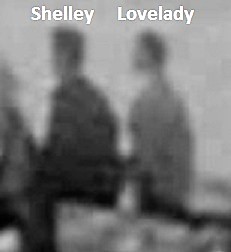
So, there is no reason to doubt that Shelley did that or to put stock in any other claim he made. He was NOT out front at 12:33 or 12:34 when Oswald left for home. And Oswald was not a stupid man. He was smart enough to know that it was pointless to claim that someone saw him when he didn't since he had no arrangement with Shelley to lie for him. So, when Oswald said it, he must have believed that Shelley would confirm it. So, why didn't Shelley confirm it? Because Shelley was in on it. Shelley was a conspirator. Shelley was framing Oswald. Shelley is the one who lied- not Oswald.
And Lee had no
reason to lie about that or anything. He wasn't committing a crime in
leaving for home, and he did not need an alibi for it. Therefore, he
must have been referring to seeing Shelley when it mattered- during the
motorcade.
And, think about what it means to be "with" somebody. It means to be situationally tied to them, where you are doing something together, if only standing around. If you're standing in a crowd, you could be shoulder to shoulder with someone, but you're not "with" them. But, Oswald said he was "with Bill Shelley in front." Well, that certainly didn't happen after the assassination because the time doesn't allow it. Oswald got home at 1:00. He was spotted in the Texas Theater at 1:07 by Butch Burroughs, the popcorn man. Upon leaving the TSBD, Oswald had to walk 6 blocks down Elm Street, take the bus, get mired on the bus, get off the bus after waiting for a transfer ticket, walk 6 blocks to the bus depot, get a taxi, engage with a woman who also wanted the taxi and offer it to her, then ride the taxi for 2 miles through heavy traffic to a spot 6 blocks past his boarding house and then walk back. Then, he had to change his pants, presumably get his pistol (it's just a presumption the pistol was there) and do whatever else he did before leaving. How does that leave time for him to be "with" anybody out front after the assassination? The clock was ticking. So, if Oswald saw Bill Shelley in front as he was leaving, it's likely he would have said that he saw Bill Shelley, not that he was "with" Bill Shelley. Words have very specific meanings; it's one of the beautiful things about the English language. And the meaning of "being with" someone is that you are implanted in a spot or engaged in an activity with that person. And that can't possibly be true of Oswald as he was leaving the TSBD since there was no time for it. But really, this is overkill because we have solid evidence from multiple witnesses, including Shelley, and his capture in a film which shows that Shelley left immediately with Billy Lovelady for the railroad tracks and did not return to the front. We can see him doing it. So, Bill Shelley was NOT there when Oswald left for home. And therefore "out with Bill Shelley in front" could ONLY and necessarily refer to the time of the motorcade. That is when Lee Harvey Oswald was out with Bill Shelley in front.
And, think about what it means to be "with" somebody. It means to be situationally tied to them, where you are doing something together, if only standing around. If you're standing in a crowd, you could be shoulder to shoulder with someone, but you're not "with" them. But, Oswald said he was "with Bill Shelley in front." Well, that certainly didn't happen after the assassination because the time doesn't allow it. Oswald got home at 1:00. He was spotted in the Texas Theater at 1:07 by Butch Burroughs, the popcorn man. Upon leaving the TSBD, Oswald had to walk 6 blocks down Elm Street, take the bus, get mired on the bus, get off the bus after waiting for a transfer ticket, walk 6 blocks to the bus depot, get a taxi, engage with a woman who also wanted the taxi and offer it to her, then ride the taxi for 2 miles through heavy traffic to a spot 6 blocks past his boarding house and then walk back. Then, he had to change his pants, presumably get his pistol (it's just a presumption the pistol was there) and do whatever else he did before leaving. How does that leave time for him to be "with" anybody out front after the assassination? The clock was ticking. So, if Oswald saw Bill Shelley in front as he was leaving, it's likely he would have said that he saw Bill Shelley, not that he was "with" Bill Shelley. Words have very specific meanings; it's one of the beautiful things about the English language. And the meaning of "being with" someone is that you are implanted in a spot or engaged in an activity with that person. And that can't possibly be true of Oswald as he was leaving the TSBD since there was no time for it. But really, this is overkill because we have solid evidence from multiple witnesses, including Shelley, and his capture in a film which shows that Shelley left immediately with Billy Lovelady for the railroad tracks and did not return to the front. We can see him doing it. So, Bill Shelley was NOT there when Oswald left for home. And therefore "out with Bill Shelley in front" could ONLY and necessarily refer to the time of the motorcade. That is when Lee Harvey Oswald was out with Bill Shelley in front.
The Altgens6 was Altered
It would have
been unbelievably remiss of Detective Fritz not to have asked Lee Oswald
where he was at the time of the shooting. That was the most important
question Will Fritz would have needed to ask. Hence, three questions
arise about what Lee told Fritz:
(1) Why would Lee have said that he was out in front if it were not true?
I am directing that to those who realize that he was not up on the 6th floor shooting at the President.
I am directing that to those who realize that he was not up on the 6th floor shooting at the President.
(2) Why mention Shelley unless Lee believed that Shelley would confirm it?
(3) How could he know that Shelley was out front unless he saw him there?
These questions appeared to me to create a prima facie case that Lee was telling the truth during his interrogation. I
therefore began to take a closer look at Altgent6 and was astonished to
discover—and on a John McAdams site!—that Altgens6 was altered:
Now I am NOT talking about Doorman but the figure
to his left/front (to the right of Doorman as we view him, and circled
in red above, and in white below).
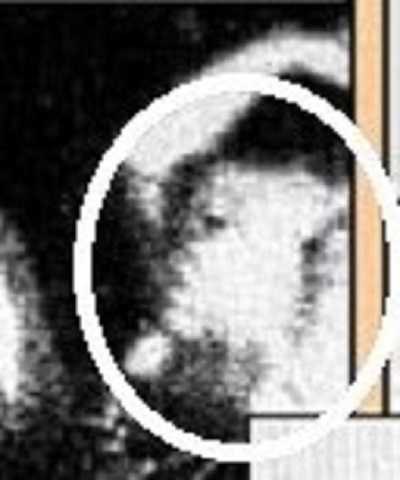
Now, I ask you: Does that not look like a photographic aberration? Like something you have never seen before in a natural, unaltered photo? Does it look like a spontaneous photographic occurrence? And if you claim that it does, then you show me another one like it. I originally inferred that the face that was obfuscated must have been that of Lee Oswald, but I now believe, based on new research by Larry Rivera, that he was TSBD Vice President Otis Williams. His image departs from the norms of photography enough to declare that photographic manipulation took place to obfuscate him. They tried to make him unrecognizable. Why? We can only speculate about that. But, I would say it was to disassociate him from the Doorman controversy. Otis Williams did testify to the Warren Commission, and he said he couldn't remember who was on the steps with him. He refused to cite a single name. The following graphic was made by OIC Chairman Larry Rivera.
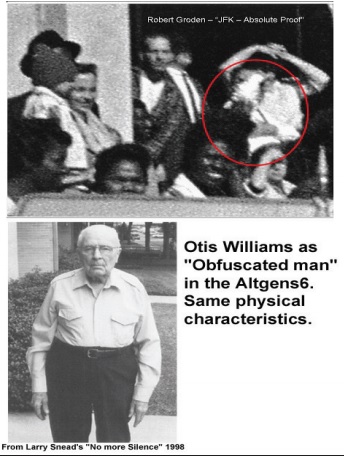

Now, I ask you: Does that not look like a photographic aberration? Like something you have never seen before in a natural, unaltered photo? Does it look like a spontaneous photographic occurrence? And if you claim that it does, then you show me another one like it. I originally inferred that the face that was obfuscated must have been that of Lee Oswald, but I now believe, based on new research by Larry Rivera, that he was TSBD Vice President Otis Williams. His image departs from the norms of photography enough to declare that photographic manipulation took place to obfuscate him. They tried to make him unrecognizable. Why? We can only speculate about that. But, I would say it was to disassociate him from the Doorman controversy. Otis Williams did testify to the Warren Commission, and he said he couldn't remember who was on the steps with him. He refused to cite a single name. The following graphic was made by OIC Chairman Larry Rivera.

Taking a Closer Look
That the Altgens6 was altered at all creates the presumption that something was wrong. Surely it would only have been altered if someone had been there who should not have been there. The only candidate for that would have been Lee Oswald. While
I now believe that the face that was obfuscated was that of Bill
Shelley, his importance would only become apparent after Oswald’s
remarks to Fritz were made public, which did not occur until 1997.
However, the conspirators had to know all along of Shelley's
importance. In
my first article about it, "JFK: What we know now that we didn't know
then" I mistakenly suggested that the obfuscated face was that of Lee,
which led Ralph Cinque to contact me to explain why he thought that I
was right about my conclusion—that Oswald HAD been in the doorway—but I
was wrong about which figure he was. He also explained that Doorman's
clothing was the key to his identification.
It
did not take long for Ralph to convince me that he was right, which led
to our joint article, JFK Special: Oswald was in the doorway after all.
The uniqueness of Oswald's clothing had never really been addressed
before. Well, perhaps it had, but not in a long time, and not with any widespread recognition. When
you compare the clothing of Oswald and Doorman -in detail- you realize
it had to be the same clothing, which means it had to be the same man. Unless
Billy was wearing Lee’s clothing, the probability that Doorman was
Lovelady approaches zero and the probability Doorman was Lee approaches
100%. Not only is there no
serious chance that Billy Lovelady just happened to dress himself
exactly the same way as Lee Oswald on that fateful day, but Billy
himself would go to the FBI and show them the shirt that he wore that
day —an incredibly implausible thing to do unless it were true—and it
was not the shirt of Doorman! It was, in fact, a short-sleeved,
vertically-striped shirt that Billy showed them.
Inference to the Best Explanation
As you will find
on the pages of the Oswald Innocence Campaign, Ralph Cinque and Richard
Hooke have done brilliant work in displaying the full range of
alterations to which this photo has been subjected, where the more they
have done, the stronger the case has become. Anyone familiar with the
principles of scientific reasoning--most importantly, of inference to
the best explanation--will have no difficulty appreciating that the case
for alteration has been made- again and again. The
complexity of what was done is rather astonishing, but the price of
failure would have been to blow apart the greatest hoax in American
history, namely: that JFK was killed by Lee Harvey Oswald, a lone,
demented gunman. We know that cannot be true on multiple grounds, and
this proof is as powerful as they come.
An hypothesis has been proven beyond a reasonable doubt when no alternative hypothesis is reasonable. There would have been no reason to alter Altgens6 unless someone had been there who should not have been. Altgens6 was altered. Therefore, someone was there who should not have been. The only person that could have been was Lee Oswald, the designated “patsy”. Questions
have long revolved over the identity of Doorman, but they were pursued
in the past in ignorance of what Lee told Fritz and without the
knowledge that Altgens6 altered--and not just once, but many times. We
maintain that the man in the checkered shirt they came up with later is
bogus, and he was used to bridge the gap between the shirt that Oswald
wore and the one that Billy Lovelady wore--which was not checkered but
striped and short-sleeved.
There is no
reasonable alternative to the hypothesis that Lee Oswald was the Man in
the Doorway. And it proves that the official account of the JFK
assassination is a lie, a fabrication, and a charade. Beyond a
reasonable doubt, the charade has been exposed. At this time, and
forever more, there is no basis or excuse for anyone to claim or believe
that Lee Harvey Oswald murdered President John F. Kennedy.
This overlay by OIC Chairman Larry Rivera is the most advanced image
analysis that has ever been done in studying the Doorman issue. The
match to Oswald is compelling.
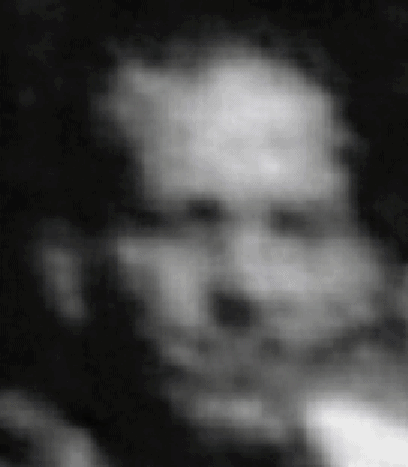
Here it is again without any tint, if you prefer that.

That's how well Oswald's face fits over Doorman's, and the idea that Doorman could be any other man is preposterous and stupid. The extent to which their faces match is truly breathtaking. Looking at them side by side, it defies logic, reason, and instinct to even try to deny they are the same person. But, as we shall see, a cunning thing was done to turn Oswald into Lovelady. What they did was move over the top of Lovelady's head, including his hairline, and plop it down on Oswald--in a vain attempt to "Lovelady-ify" him. But, let's start by looking at this collage of Oswald and Doorman, noting the likeness of the man and the clothing. Lee Harvey Oswald and the Altgens Doorman were one and the same man.

Notice first that they are both wearing long-sleeved shirts. That may not seem to be an especially important point, but it is. That's because for months following the assassination, Billy Lovelady claimed to have worn a short-sleeved shirt with red and white vertical stripes. He even went to the FBI to show them that shirt. He even posed in it unbuttoned- like Doorman- for pictures. On the Lovelady page, we will show you a picture of him posing for FBI agents in that shirt. But here note that both Oswald and Doorman were wearing a long-sleeved shirt.
Notice second that both shirts were substantially unbuttoned. Doorman's shirt was sprawled wide open and Lee's a little less so, and that's because he was pressing his cuffed hands to his abdomen. But the substantial unbuttoning is clearly present on both.
Is there any evidence that Billy Lovelady wore his shirt that way that day, also unbuttoned? No one on the Warren Commission ever asked him anything about his shirt and how he wore it. Billy died unexpectedly of a heart attack at the age of 41, just before the House Select Committee on Assassinations would publish its Final Report in January 1979. Was he killed? Let's just say the circumstances were suspicious. It's unusual for a 41 year old to die of a heart attack. I know it happens, but statistically, it is unusual
Then notice the v-shaped t-shirt. The opening was sunken into a crude v on both.
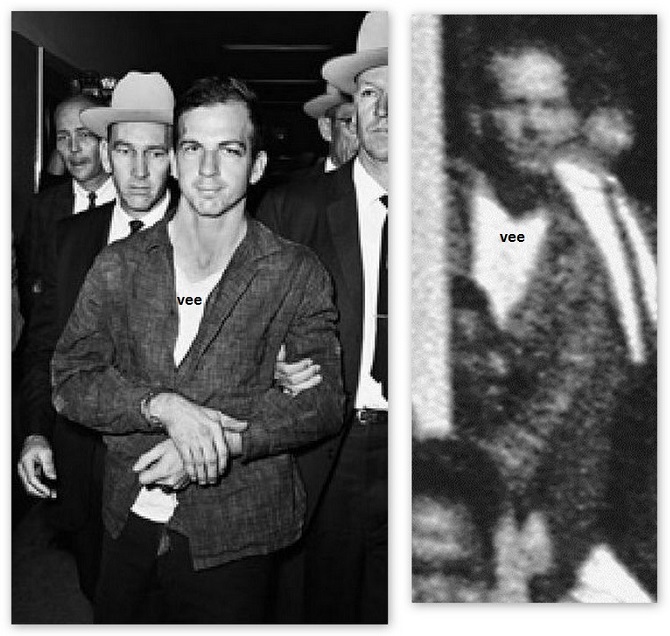
There is no evidence that the FBI or the Dallas Police ever asked Billy Lovelady whether his shirt was sprawled open or if his t-shirt was notched instead of round. Oswald's buttons were missing, so he had no choice but to leave it open. But, did Billy do that? We know he claimed to have sat down on the steps outside the TSBD to eat his lunch. Would he likely have eaten his lunch that way, sitting there on a step and bringing food up and down his open shirt? Why would he do that? Why wouldn't he wear it the normal way, with all the buttons secured except the top one? That is most likely what he did.
Notice also that Doorman's shirt was not just unbuttoned-- it was sprawled open. It was parted like the Red Sea. This is important because in the most widely circulated image of Lovelady from 22 November, his shirt was definitely not sprawled open. Look below.

The picture on the right above was taken, supposedly, just 15 minutes after the Altgens6 photo. Does his shirt look sprawled open like Doorman's? There is no evidence that Billy or anyone else ever said anything about him going around with his shirt substantially unbuttoned that day--never mind sprawled open. (Later, we shall explain why the figure on the right in the checkered shirt was actually a Lovelady impostor from a phony film clip. But officially, the two figures above were both Billy Lovelady.)
In Oswald's case, he had no choice about the unbuttoning because his buttons were missing. Mary Bledsoe reported that, while riding the bus home, Oswald wore his shirt wide open and his buttons were missing. And that was before his altercation with Dallas police at the Texas Theater. Note also that Lee did not change his shirt at his room, and even the Warren Commission agreed. His bus transfer ticket was found in the pocket of his arrest shirt. Even Lee himself made it clear that he only changed his trousers- not his shirt. "When I left the Texas School Book Depository, I went to my room where I changed my trousers, got a pistol, and went to a picture show."
Our opponents have pointed out that the above image of Lovelady was taken from a movie in which his shirt does, for a split-second appear to be unbuttoned. I have watched that movie, frame by frame, seeking the most open view of the shirt. Here it is, alongside Doorman's.
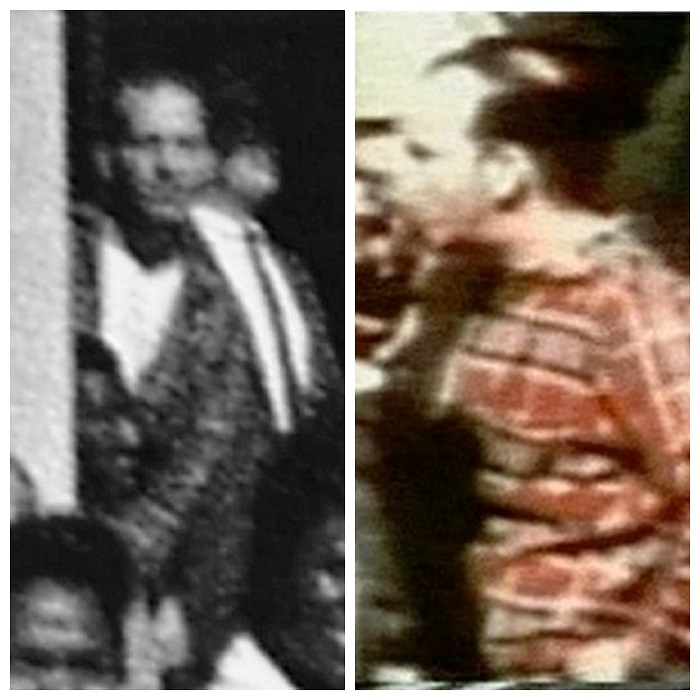
You see that narrow sliver of white on the right on Lovelady? That is what they are talking about, believe it or not. What is it? Is it even real? Do unbuttoned shirts really behave like that? Is that comparable to what we see on Doorman? Of course not. It looks like they forgot to sprawl open his shirt, so they tried to fix it. They overlooked the need for the shirt to be unbuttoned when they made the phony movie and then went back afterwards to add the white sliver. How hapless and pathetic is that? We will have more to say about that phony movie on the next page. You'll notice in multiple images that Oswald's shirt was loose-fitting. You see it bunching and folding from excess material. That's because Oswald lost weight between New Orleans and Dallas. His shirt would sprawl open like Doorman's. It was the same shirt and a very unique one. It was more of a shirt-jacket. It was a hybrid between a shirt and a jacket. It was lightweight like a shirt, but it had the lay of a jacket. It tended to fold over like a jacket. You can't find a shirt like that in the USA today, and I doubt you could find it then. Oswald must have brought it back with him from Russia. That's right; the Man in the Doorway was wearing a Russian shirt. How unfortunate for the conspirators that Oswald chose to wear such a unique shirt that day.
Here is an update as of November 2013: We have a quote now from Marina Oswald Porter obtained by Tom Rossley confirming that it was Oswald's shirt on Doorman. "That's Lee's," she said when asked. She went on to say that she's the one who washed it.
But, notice in the collage directly above that on the right, the man's shirt looks form-fitting and snug. Notice how tight it looks across his chest. He was a bigger, stockier man, with a barrel chest, and he filled out his shirt much better than Doorman. The weight difference between them had to be at least 30 pounds. And notice that the man's face looks hard, while Doorman's face looks soft. Notice how with his long, sloping forehead and prominent brow bone, the other guy reminds you of a caveman, a Neanderthal. You don't get that impression about Doorman, do you? So, they had to be different men. (On the next page, we explain why this Lovelady figure had to be an imposter. He wasn't Doorman, and he wasn't even Lovelady).

In the collage above, on the left is Lee's mug shot from being arrested in New Orleans in August 1963; and on the right, you see him after his arrest in Dallas on 22 November 1963. It is rather obvious that he lost weight. Look how much fuller his face looks on the left. At that time, he weighed 140 pounds, and note that the New Orleans Police weighed him. It was not an estimate- they put him on a scale. And that is not a lot of weight for a 5'9" young man. And, on someone that light, even a 5 pound weight loss would have a dramatic effect on how his clothes fit. To Ralph's seasoned eye as a weight-loss doctor, Lee lost around 8 pounds between New Orleans and Dallas--which would have put him at 132 pounds. However, we later learned from Dr. Gerald McKnight that Oswald was weighed in Dallas and found to be 131 pounds. And that explains why his shirt looked so big on him-- both in the doorway and after his arrest.

Some have tried to attribute the difference to a difference in lens focal length, but that is ridiculous. On the right is another image of Oswald showing how skinny he was. The man obviously lost weight.
And note that Billy Lovelady was a much heavier man. On February 29, the FBI weighed and measured him at 5'8", 170 pounds. So, with Oswald at 5'9", 131 pounds, it's fair to say that the physical resemblance between the two of them has been greatly exaggerated. They were more like Laurel and Hardy.
There is one last point about the first collage at the top of this page before we move on. Notice the V-neck t-shirt on both. This was a self-made V-neck because Lee had the habit of tugging down on his t-shirt, hence stretching it and deforming it. This was reported by his close friend from the Marines, Anthony Botelho.
Here is a chart concerning the V-neck t-shirt which was made by Richard Hooke:

The degree to which the V manifested would fluctuate depending on whether the t-shirt was pulled down in front or down in back. When it was pulled down in front, then the V became prominent, but not so if it was pulled down in back. Note that there are some photos of him in which you can barely see the V at all, and there are also some photos in which the V is more pronounced than it is on Doorman. What we see on Doorman is about average or middle-of-the-road for how it went. But note that Billy Lovelady never at any time wore anything but a tight, round, high, crewneck t-shirt, and that included on 22 November 1963.
Here is another collage by Richard Hooke which shows the seam around the margin of the t-shirt, and it also shows the impression from the thumb-tug, which was Oswald's habit. Richard considers this collage to be the ultimate proof of Oswald's presence in the doorway.

Here is one more collage by Richard Hooke dealing with the v-shaped t-shirt. You have to realize that if Doorman was wearing a v-shaped t-shirt, it's over--he had to be Oswald. He could not have been Lovelady or anyone else. And he obviously appears to be wearing a v-shaped t-shirt, which not even our opponents can deny. All they can do is claim that it was an optical illusion, that beneath that v-shaped darkness there was a perfect white crewneck t-shirt, that of Lovelady's. But, that is wishful thinking to the max. The vee, which is plainly seen, is the vee of the t-shirt. The shadow claim for the vee is completely bogus, and all you have to do to know it is look at shadows under chins. They are never perfectly v-shaped and symmetrical and balanced and centered as we see on Doorman. They are usually awkward and asymmetrical and with no distinct shape at all. I have been looking at such shadows, literally, for years, and I have never seen one that matched the vee we see on Doorman or even came close to it. It's not shadow; it's the shape of his t-shirt, Oswald's t-shirt. And keep in mind that no one has ever brought forth an image in which a round t-shirt was made to look perfectly vee-shaped due to chin shadow. They haven't produced it, and they have never found it. It's really just a desperation ploy from knowing that it's game, set, match because of that vee-shaped t-shirt.
 /
/
Below we see three nice vees under the necks of three different people in the Altgens photo. Note that they were all standing in different places at completely different angles to the sun.
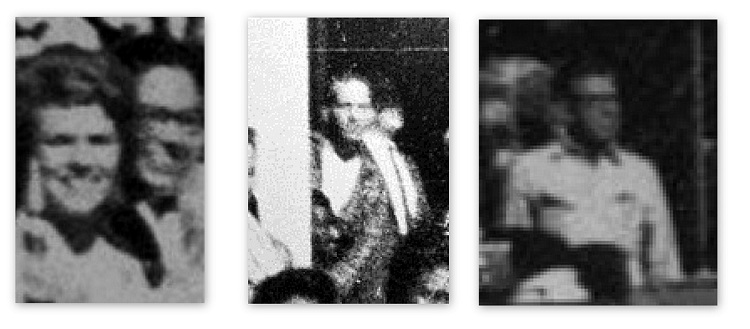
Be aware that neck shadows don't form perfect vees--period. They just don't. Here, we are seeing it three times in one photo and at different angles. So, is it really neck shadow? No! It's really just their exposed skin. The film was very high-contrast, or you could say highly polarized. Mid-tones were pushed to dark, even black, and light-tones were pushed to white. You can't assume that all three people above were laying down perfect vee shadows. The vee shapes are just the shapes of their exposed skin. That's what's driving it. Notice that the dark man on the right has a smaller, sharper vee than the others, and that's because his shirt wasn't opened as much, and not as much of his skin was exposed. On Doorman, the dark area corresponds to his exposed skin. His t-shirt looks vee because it was vee. An explicit shadow would be sloppy, uneven, asymmetrical, and lopsided--not perfect the way his is. We are seeing the actual junction between his skin and his t-shirt.
If our critics really believe that the vee is due to shadow, why don’t they get a camera out and demonstrate it? And even if they did, it would only be a first step. They would still have to go to Dealey Plaza in late November and do it there. And I’ve already done that. This is from November 17, 2012 with me (Ralph) standing in the doorway exactly where Doorman stood at 12:30. I am at the center of the doorway, which is where he was and where we see him in the Dave Wiegman film below. From Altgens’ angle, he appears to be partially behind the white column, but that is the result of parallax. As you can see, there is no vee-shaped shadow.

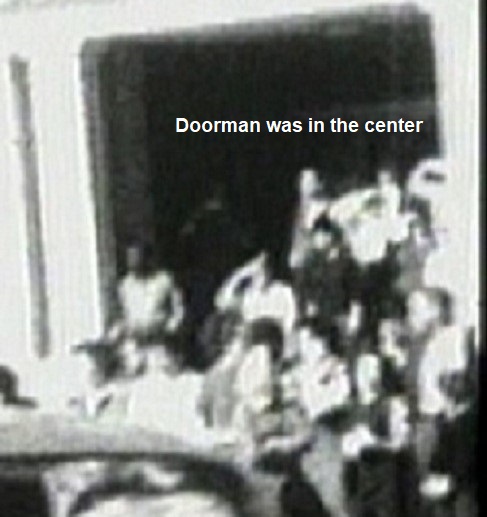
Consider the next collage below. Note first that you can see the same likenesses as with the first collage: unbuttoned, loose-fitting, long-sleeved outer shirt over vee-shaped t-shirt.
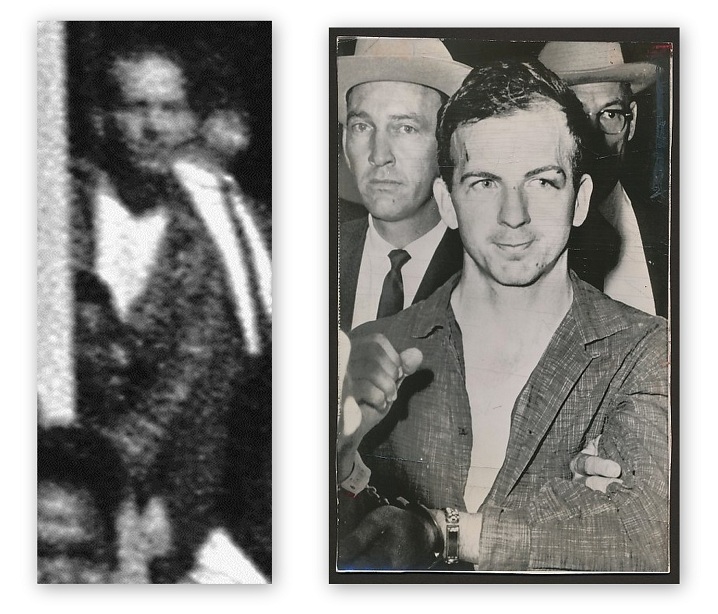
But now look at the collars. The right collar on both of them (on our left, as we look at them) shows a collar and below it a small furl or pseudo-lapel. It is just a little, neat curl of the material, with a vertical margin, that looks very much the same on both of them. The right margin of both shirts rises practically vertically, and above it is the flap, and they are identical.

On the other side, their left side (therefore, on our right, as we look at them) we see on Oswald a long lapel, which effectively turned his shirt into a jacket. Yes, his shirt had the lay of a jacket on its left side. On Doorman, there is a lot of distortion in that area, and we suspect that they manipulated the position of his upper arm, about which we will have more to say later. But for now, notice simply that the margin of his shirt on his left (our right) looks thicker and bulkier than the other side. It looks thicker because it is folded over, doubled over, into a lapel. The other side, his right side (which is on our left), looks thin and flimsy, in comparison. And that's because there is only one layer of material there and a sharp edge. On his left side, the edge is rounded over into a fold, which gives it a thicker, blunter look. It's folded over, just as we see on the right.

Can you see that left lapel on both? And notice that on both that it tends to bulge in spots. It doesn't lie perfectly flush with the crease. And notice again how much thicker the material of Doorman's shirt looks on his left side than his right. That is because it is folded over into a lapel on his left side.
Do you think Billy Lovelady wore a shirt that looked anything like that? Of course, he didn't. In none of the images of him did his shirt look anything like that. But now, let's add Billy's collar to the mix.
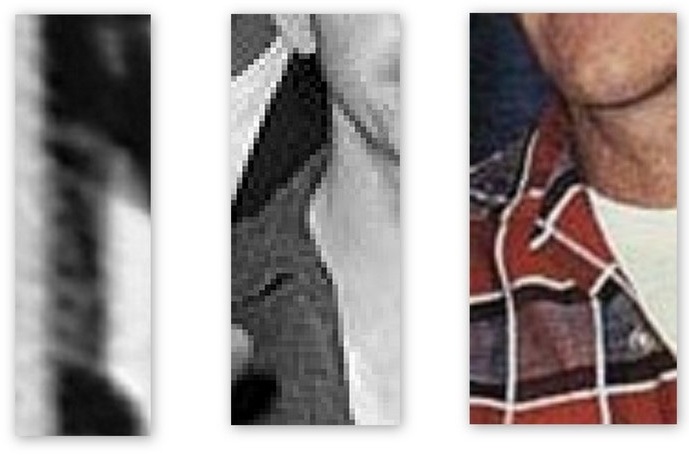
Billy's photo on the right was taken in 1976, but supposedly, it was the very same shirt. We don't think there is any chance that he actually wore that shirt on 11/22/63, but we'll put that aside for now. But, he was definitely doing all he could to duplicate the look of Doorman. He was posing. He was wearing a costume. Notice first his crewneck t-shirt. In every picture we have of him, his t-shirt is high and round. On his outer-shirt, observe the rich, varied pattern that went all the way up to the collar. Notice that Doorman's outer-shirt just looks grainy in its pattern- like Oswald's. The patterns match very well between the two of them, but not Lovelady.
Note that Doorman's shirt has vague contrast, some light/dark, but that is due to the extreme blowup of the image and to haze and distortion. It is not plaid. There is nothing plaid about it. Plaid means horizontal and vertical lines crossing and forming boxes. There is not a single box on Doorman's shirt. It is simply false to say that Doorman's shirt is plaid. The fact that the light/dark is completely absent from the right collar is proof that the rest is just noise, not a shirt pattern. We will be looking at this further on the Lovelady page. What it means is that there was really nothing about Doorman's clothing that matched to Lovelady. Nothing at all. It was Oswald's vee-shaped t-shirt and Oswald's distinctive Russian shirt. In clothing, Doorman was 100% Oswald and 0% Lovelady.
But before we leave this, go back to the tri-collage and notice that unsecured button on Billy's shirt. That button tells you that the shirt was not supposed to be worn the way he was wearing it. That button was supposed to be buttoned, which means that the open sprawl that you see on Lovelady is artificial. It looks natural and spontaneous on Oswald and Doorman, but not on Lovelady. On him, it seems to have been a deliberate attempt to arrange the shirt in the style of Doorman. Billy was trying mighty hard--too hard--to take on the look of Doorman. And again, look at that tight, round, high, crewneck t-shirt on Lovelady. Billy's t-shirts always looked like that. And why shouldn't they have? He didn't have the nervous habit of tugging down on his t-shirts. That was Lee's habit, not Billy's. The shape of the t-shirt alone clinches it for Oswald.
Here's a good one: The little furl below the right collar on Oswald had an accordion-like effect; it crinkled. And we can see the same thing on Doorman. Catch the crinkle!
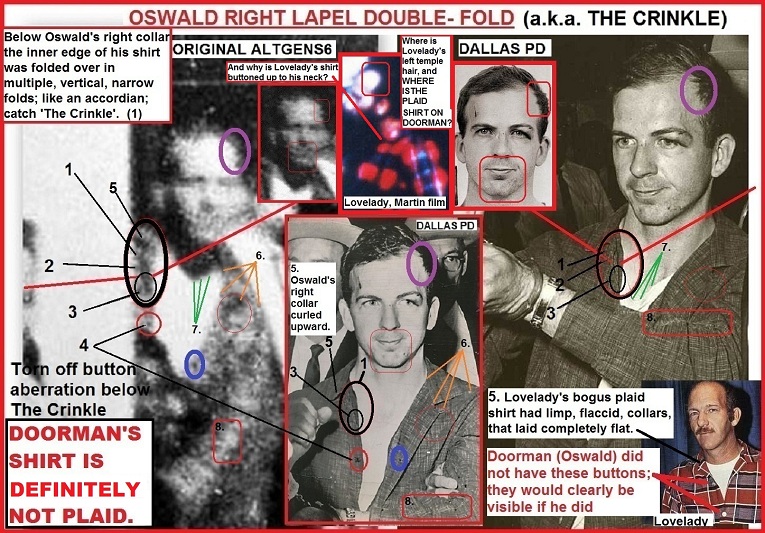
Look at the multiple folds on both. Same exact spot; same exact behavior of the material; same guy. And notice Lovelady's prominent white buttons, which are absent on Doorman.
Both Doorman and Oswald are lacking buttons. Below the crinkle, there is a hole which was left behind after the button came off, and it's circled. It is distinctly visible on both of them and labelled number 4. A white button would be visible on Doorman's dark shirt if present.
And there are more facial features that match between Oswald and Doorman. Look at the collage below and notice how well the right ears match between the two of them. And note that ears are as distinctive and distinguishing as fingerprints.

Notice that the shape, the contour, the angle, and the position of the ears are a perfect match between Doorman and Oswald. But did Lovelady's ear match Doorman's ear equally as well? I am afraid not.

A fine chart that displays their differences has been prepared by Richard Hooke. Consider:

So, Oswald's and Doorman's right ears match perfectly, while Lovelady's and Doorman's do not. You can see another good match-up of the ears in the collage below.

The above collage shows the excellent likeness of the faces of Oswald and Doorman. We are certain that they did one thing to Lovelady-ify Doorman, and that is to replace his forehead and hairline. Doorman does seem to have a hairline pattern closer to Lovelady (although we will demonstrate later that it is a match to Lovelady when he was much younger). Yet, the facial size, shape, and contour still favor Oswald over Lovelady as Doorman. Even the facial expressions are a good match. Look at those tight pressed lips on both of them. It is obviously the same man we are looking at. The shape of the hairline and the top of the head are Billy's, but that's all. The rest of Doorman is all Oswald.
And that includes his chin. Doorman had a square chin like Oswald, not a long a round chin like Lovelady. Look at this funny chart by Richard Hooke:

Who is kidding who? That is Oswald's square chin on Doorman.
And speaking of habits, Oswald really did have the habit of pursing his lips. Here is another example of it in the collage below, where you can see both Oswald and Doorman doing it- and rather tightly. On the right, Oswald's hands are clasped together in front-no doubt spurred by his being in handcuffs- but, it was a common stance of his, apart from being handcuffed. Could Doorman be doing the same thing on the left? It sure looks like it. What else could explain the position of his arm being swung over to the inside the way it is? He wouldn't do that for no reason. He wouldn't just hold his arm that way, suspended in the air, which would be uncomfortable and tiring. He didn't have a spastic condition such as Parkinson's disease, did he?--and that is about the only other thing that could account for it. And before someone suggests that he was holding onto something, there was nothing else for him to be holding onto except his other hand. This appears to be one man engaged in two spontaneous behaviors -- pursing his lips and clasping his handsd. People are creatures of habit, and so was Lee Harvey Oswald.

If you scroll up to the very first collage on this page, you will see that Lee is clasping his hands there as well. Again, he is in handcuffs, but not everyone in handcuffs does that. Most do not. Some people clasp their hands in front. It's a habit. And it was Oswald's habit. It is comfortable, and it is non-threatening. And in a crowded situation- such as on those Depository steps--clasping your hands would keep your arms out of other people's way. It's a way of containing yourself, making yourself a tighter, more compact package. So, there was a practical reason for Oswald to stand that way in the doorway. But regardless, it was his habit to stand that way. We have found several images of him doing it, including right before he got shot.
And if you are inclined to think that Oswald was only clasping his hands because he was in handcuffs, then here's a picture of him doing it without handcuffs. This was taken right before he was to enter a lineup, and they had removed his handcuffs because of the lineup. If you look closely, you can see that there is an impression made over the skin of his left wrist from where he was recently cuffed. But, he is not wearing any cuffs in the picture. Yet, he is still grasping his right wrist with his left hand.
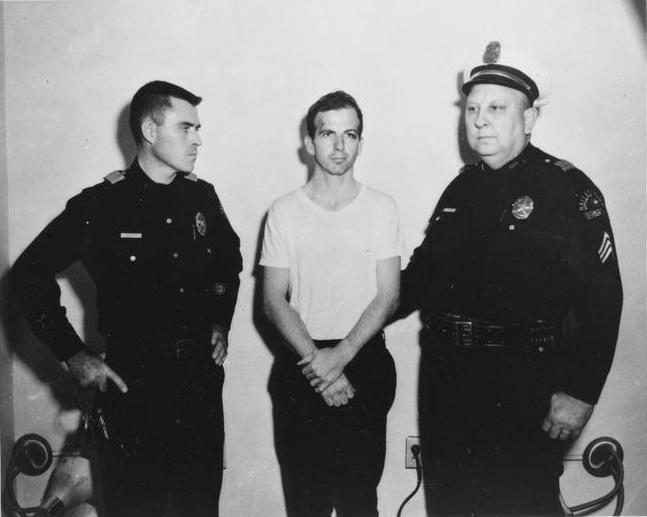
Below is the same picture as above but enlarged and placed next to Doorman. Don't they look the same?

Granted, you can't see Doorman's right arm or his left hand, but don't they appear to be doing the same thing? It is riveting how well matched they are. The position and angle of the forearm are the same on both. And Doorman is clasping his hands the same way: left over right. This is the same man performing the same behavior, for sure.
Yes, these guys really look alike. Both have the same long neck. Both are pursing their lips. Oswald's shoulders look balanced and even, while at first glance, Doorman looks like he is leaning to his left (our right). But, he isn't. That is an illusion, as I will explain.
Actually, Doorman's left shoulder is cut off. His left shoulder is missing. The figure of the man next to him was placed there in a photographic fakery. And it creates a quandary as to who is standing in front of whom: Doorman or that man cinched up next to him, whom we call Black Tie Man. It is the equivalent of Escher's "Impossible Cube" and we shall address it further under "Anomalies". No authentic photograph can include anatomically impossible features as this one does. We consider Doorman's missing left shoulder to be a major anomaly of the Altgens photo, of which there are many.
And why did they keep marching Oswald around in just his t-shirt? Why did they take away his outer shirt? And he complained about it too. Was it because they didn't want the public to form too many mental images of him in that sprawled-open, loose-fitting, and very unusual outer shirt with the distinctive collars and lapels which they could later compare to the Altgens photo?
Richard Hooke has put together a most riveting comparison, and I call it the "Neuromuscular collage" because it concerns the fine, subtle neuromuscular habits that everyone has. Each of us is a neuromuscular bundle, in which, over time, we acquire distinctive neuromuscular habits- to hold ourselves and use ourselves in a certain way. You know how a person's handwriting is distinctive-it being the result of neuromuscular habit. But even the way you stand, the way you tweak your head a certain way, lift your chin a certain amount- you could call it your bodily signature- and everyone has one.

Well, it turns out that Doorman's "bodily signature" was exactly the same as Oswald's- and that's because he was Oswald. The vector lines that Richard drew in are all the result of Oswald's subconscious postural habits- his personal bodily signature. That is the same man you are looking at with his own unique, personalized pattern of bodily balance and support.
Doorman's nose is definitely that of Oswald and not Lovelady. Billy's nose was wider and more bulbous and had less flare to the nostrils. Here is a chart by Richard Hooke showing the excellent nasal match between Oswald and Doorman.
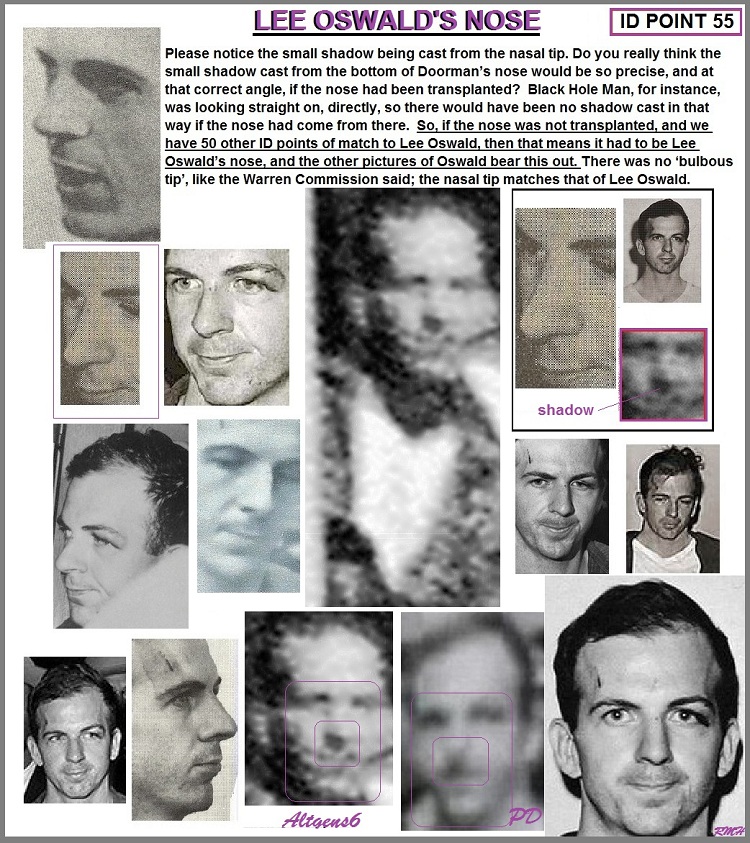
And since we're on a roll, let's take a look at another excellent match-up.
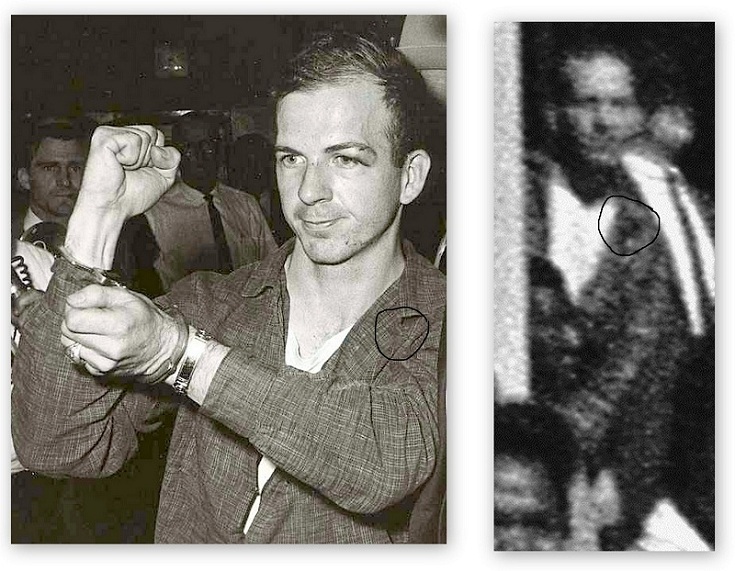

Here it is again without any tint, if you prefer that.

That's how well Oswald's face fits over Doorman's, and the idea that Doorman could be any other man is preposterous and stupid. The extent to which their faces match is truly breathtaking. Looking at them side by side, it defies logic, reason, and instinct to even try to deny they are the same person. But, as we shall see, a cunning thing was done to turn Oswald into Lovelady. What they did was move over the top of Lovelady's head, including his hairline, and plop it down on Oswald--in a vain attempt to "Lovelady-ify" him. But, let's start by looking at this collage of Oswald and Doorman, noting the likeness of the man and the clothing. Lee Harvey Oswald and the Altgens Doorman were one and the same man.

Notice first that they are both wearing long-sleeved shirts. That may not seem to be an especially important point, but it is. That's because for months following the assassination, Billy Lovelady claimed to have worn a short-sleeved shirt with red and white vertical stripes. He even went to the FBI to show them that shirt. He even posed in it unbuttoned- like Doorman- for pictures. On the Lovelady page, we will show you a picture of him posing for FBI agents in that shirt. But here note that both Oswald and Doorman were wearing a long-sleeved shirt.
Notice second that both shirts were substantially unbuttoned. Doorman's shirt was sprawled wide open and Lee's a little less so, and that's because he was pressing his cuffed hands to his abdomen. But the substantial unbuttoning is clearly present on both.
Is there any evidence that Billy Lovelady wore his shirt that way that day, also unbuttoned? No one on the Warren Commission ever asked him anything about his shirt and how he wore it. Billy died unexpectedly of a heart attack at the age of 41, just before the House Select Committee on Assassinations would publish its Final Report in January 1979. Was he killed? Let's just say the circumstances were suspicious. It's unusual for a 41 year old to die of a heart attack. I know it happens, but statistically, it is unusual
Then notice the v-shaped t-shirt. The opening was sunken into a crude v on both.

There is no evidence that the FBI or the Dallas Police ever asked Billy Lovelady whether his shirt was sprawled open or if his t-shirt was notched instead of round. Oswald's buttons were missing, so he had no choice but to leave it open. But, did Billy do that? We know he claimed to have sat down on the steps outside the TSBD to eat his lunch. Would he likely have eaten his lunch that way, sitting there on a step and bringing food up and down his open shirt? Why would he do that? Why wouldn't he wear it the normal way, with all the buttons secured except the top one? That is most likely what he did.
Notice also that Doorman's shirt was not just unbuttoned-- it was sprawled open. It was parted like the Red Sea. This is important because in the most widely circulated image of Lovelady from 22 November, his shirt was definitely not sprawled open. Look below.

The picture on the right above was taken, supposedly, just 15 minutes after the Altgens6 photo. Does his shirt look sprawled open like Doorman's? There is no evidence that Billy or anyone else ever said anything about him going around with his shirt substantially unbuttoned that day--never mind sprawled open. (Later, we shall explain why the figure on the right in the checkered shirt was actually a Lovelady impostor from a phony film clip. But officially, the two figures above were both Billy Lovelady.)
In Oswald's case, he had no choice about the unbuttoning because his buttons were missing. Mary Bledsoe reported that, while riding the bus home, Oswald wore his shirt wide open and his buttons were missing. And that was before his altercation with Dallas police at the Texas Theater. Note also that Lee did not change his shirt at his room, and even the Warren Commission agreed. His bus transfer ticket was found in the pocket of his arrest shirt. Even Lee himself made it clear that he only changed his trousers- not his shirt. "When I left the Texas School Book Depository, I went to my room where I changed my trousers, got a pistol, and went to a picture show."
Our opponents have pointed out that the above image of Lovelady was taken from a movie in which his shirt does, for a split-second appear to be unbuttoned. I have watched that movie, frame by frame, seeking the most open view of the shirt. Here it is, alongside Doorman's.

You see that narrow sliver of white on the right on Lovelady? That is what they are talking about, believe it or not. What is it? Is it even real? Do unbuttoned shirts really behave like that? Is that comparable to what we see on Doorman? Of course not. It looks like they forgot to sprawl open his shirt, so they tried to fix it. They overlooked the need for the shirt to be unbuttoned when they made the phony movie and then went back afterwards to add the white sliver. How hapless and pathetic is that? We will have more to say about that phony movie on the next page. You'll notice in multiple images that Oswald's shirt was loose-fitting. You see it bunching and folding from excess material. That's because Oswald lost weight between New Orleans and Dallas. His shirt would sprawl open like Doorman's. It was the same shirt and a very unique one. It was more of a shirt-jacket. It was a hybrid between a shirt and a jacket. It was lightweight like a shirt, but it had the lay of a jacket. It tended to fold over like a jacket. You can't find a shirt like that in the USA today, and I doubt you could find it then. Oswald must have brought it back with him from Russia. That's right; the Man in the Doorway was wearing a Russian shirt. How unfortunate for the conspirators that Oswald chose to wear such a unique shirt that day.
Here is an update as of November 2013: We have a quote now from Marina Oswald Porter obtained by Tom Rossley confirming that it was Oswald's shirt on Doorman. "That's Lee's," she said when asked. She went on to say that she's the one who washed it.
But, notice in the collage directly above that on the right, the man's shirt looks form-fitting and snug. Notice how tight it looks across his chest. He was a bigger, stockier man, with a barrel chest, and he filled out his shirt much better than Doorman. The weight difference between them had to be at least 30 pounds. And notice that the man's face looks hard, while Doorman's face looks soft. Notice how with his long, sloping forehead and prominent brow bone, the other guy reminds you of a caveman, a Neanderthal. You don't get that impression about Doorman, do you? So, they had to be different men. (On the next page, we explain why this Lovelady figure had to be an imposter. He wasn't Doorman, and he wasn't even Lovelady).

In the collage above, on the left is Lee's mug shot from being arrested in New Orleans in August 1963; and on the right, you see him after his arrest in Dallas on 22 November 1963. It is rather obvious that he lost weight. Look how much fuller his face looks on the left. At that time, he weighed 140 pounds, and note that the New Orleans Police weighed him. It was not an estimate- they put him on a scale. And that is not a lot of weight for a 5'9" young man. And, on someone that light, even a 5 pound weight loss would have a dramatic effect on how his clothes fit. To Ralph's seasoned eye as a weight-loss doctor, Lee lost around 8 pounds between New Orleans and Dallas--which would have put him at 132 pounds. However, we later learned from Dr. Gerald McKnight that Oswald was weighed in Dallas and found to be 131 pounds. And that explains why his shirt looked so big on him-- both in the doorway and after his arrest.

Some have tried to attribute the difference to a difference in lens focal length, but that is ridiculous. On the right is another image of Oswald showing how skinny he was. The man obviously lost weight.
And note that Billy Lovelady was a much heavier man. On February 29, the FBI weighed and measured him at 5'8", 170 pounds. So, with Oswald at 5'9", 131 pounds, it's fair to say that the physical resemblance between the two of them has been greatly exaggerated. They were more like Laurel and Hardy.
There is one last point about the first collage at the top of this page before we move on. Notice the V-neck t-shirt on both. This was a self-made V-neck because Lee had the habit of tugging down on his t-shirt, hence stretching it and deforming it. This was reported by his close friend from the Marines, Anthony Botelho.
Here is a chart concerning the V-neck t-shirt which was made by Richard Hooke:

The degree to which the V manifested would fluctuate depending on whether the t-shirt was pulled down in front or down in back. When it was pulled down in front, then the V became prominent, but not so if it was pulled down in back. Note that there are some photos of him in which you can barely see the V at all, and there are also some photos in which the V is more pronounced than it is on Doorman. What we see on Doorman is about average or middle-of-the-road for how it went. But note that Billy Lovelady never at any time wore anything but a tight, round, high, crewneck t-shirt, and that included on 22 November 1963.
Here is another collage by Richard Hooke which shows the seam around the margin of the t-shirt, and it also shows the impression from the thumb-tug, which was Oswald's habit. Richard considers this collage to be the ultimate proof of Oswald's presence in the doorway.

Here is one more collage by Richard Hooke dealing with the v-shaped t-shirt. You have to realize that if Doorman was wearing a v-shaped t-shirt, it's over--he had to be Oswald. He could not have been Lovelady or anyone else. And he obviously appears to be wearing a v-shaped t-shirt, which not even our opponents can deny. All they can do is claim that it was an optical illusion, that beneath that v-shaped darkness there was a perfect white crewneck t-shirt, that of Lovelady's. But, that is wishful thinking to the max. The vee, which is plainly seen, is the vee of the t-shirt. The shadow claim for the vee is completely bogus, and all you have to do to know it is look at shadows under chins. They are never perfectly v-shaped and symmetrical and balanced and centered as we see on Doorman. They are usually awkward and asymmetrical and with no distinct shape at all. I have been looking at such shadows, literally, for years, and I have never seen one that matched the vee we see on Doorman or even came close to it. It's not shadow; it's the shape of his t-shirt, Oswald's t-shirt. And keep in mind that no one has ever brought forth an image in which a round t-shirt was made to look perfectly vee-shaped due to chin shadow. They haven't produced it, and they have never found it. It's really just a desperation ploy from knowing that it's game, set, match because of that vee-shaped t-shirt.
 /
/ Below we see three nice vees under the necks of three different people in the Altgens photo. Note that they were all standing in different places at completely different angles to the sun.

Be aware that neck shadows don't form perfect vees--period. They just don't. Here, we are seeing it three times in one photo and at different angles. So, is it really neck shadow? No! It's really just their exposed skin. The film was very high-contrast, or you could say highly polarized. Mid-tones were pushed to dark, even black, and light-tones were pushed to white. You can't assume that all three people above were laying down perfect vee shadows. The vee shapes are just the shapes of their exposed skin. That's what's driving it. Notice that the dark man on the right has a smaller, sharper vee than the others, and that's because his shirt wasn't opened as much, and not as much of his skin was exposed. On Doorman, the dark area corresponds to his exposed skin. His t-shirt looks vee because it was vee. An explicit shadow would be sloppy, uneven, asymmetrical, and lopsided--not perfect the way his is. We are seeing the actual junction between his skin and his t-shirt.
If our critics really believe that the vee is due to shadow, why don’t they get a camera out and demonstrate it? And even if they did, it would only be a first step. They would still have to go to Dealey Plaza in late November and do it there. And I’ve already done that. This is from November 17, 2012 with me (Ralph) standing in the doorway exactly where Doorman stood at 12:30. I am at the center of the doorway, which is where he was and where we see him in the Dave Wiegman film below. From Altgens’ angle, he appears to be partially behind the white column, but that is the result of parallax. As you can see, there is no vee-shaped shadow.


Consider the next collage below. Note first that you can see the same likenesses as with the first collage: unbuttoned, loose-fitting, long-sleeved outer shirt over vee-shaped t-shirt.

But now look at the collars. The right collar on both of them (on our left, as we look at them) shows a collar and below it a small furl or pseudo-lapel. It is just a little, neat curl of the material, with a vertical margin, that looks very much the same on both of them. The right margin of both shirts rises practically vertically, and above it is the flap, and they are identical.

On the other side, their left side (therefore, on our right, as we look at them) we see on Oswald a long lapel, which effectively turned his shirt into a jacket. Yes, his shirt had the lay of a jacket on its left side. On Doorman, there is a lot of distortion in that area, and we suspect that they manipulated the position of his upper arm, about which we will have more to say later. But for now, notice simply that the margin of his shirt on his left (our right) looks thicker and bulkier than the other side. It looks thicker because it is folded over, doubled over, into a lapel. The other side, his right side (which is on our left), looks thin and flimsy, in comparison. And that's because there is only one layer of material there and a sharp edge. On his left side, the edge is rounded over into a fold, which gives it a thicker, blunter look. It's folded over, just as we see on the right.

Can you see that left lapel on both? And notice that on both that it tends to bulge in spots. It doesn't lie perfectly flush with the crease. And notice again how much thicker the material of Doorman's shirt looks on his left side than his right. That is because it is folded over into a lapel on his left side.
Do you think Billy Lovelady wore a shirt that looked anything like that? Of course, he didn't. In none of the images of him did his shirt look anything like that. But now, let's add Billy's collar to the mix.

Billy's photo on the right was taken in 1976, but supposedly, it was the very same shirt. We don't think there is any chance that he actually wore that shirt on 11/22/63, but we'll put that aside for now. But, he was definitely doing all he could to duplicate the look of Doorman. He was posing. He was wearing a costume. Notice first his crewneck t-shirt. In every picture we have of him, his t-shirt is high and round. On his outer-shirt, observe the rich, varied pattern that went all the way up to the collar. Notice that Doorman's outer-shirt just looks grainy in its pattern- like Oswald's. The patterns match very well between the two of them, but not Lovelady.
Note that Doorman's shirt has vague contrast, some light/dark, but that is due to the extreme blowup of the image and to haze and distortion. It is not plaid. There is nothing plaid about it. Plaid means horizontal and vertical lines crossing and forming boxes. There is not a single box on Doorman's shirt. It is simply false to say that Doorman's shirt is plaid. The fact that the light/dark is completely absent from the right collar is proof that the rest is just noise, not a shirt pattern. We will be looking at this further on the Lovelady page. What it means is that there was really nothing about Doorman's clothing that matched to Lovelady. Nothing at all. It was Oswald's vee-shaped t-shirt and Oswald's distinctive Russian shirt. In clothing, Doorman was 100% Oswald and 0% Lovelady.
But before we leave this, go back to the tri-collage and notice that unsecured button on Billy's shirt. That button tells you that the shirt was not supposed to be worn the way he was wearing it. That button was supposed to be buttoned, which means that the open sprawl that you see on Lovelady is artificial. It looks natural and spontaneous on Oswald and Doorman, but not on Lovelady. On him, it seems to have been a deliberate attempt to arrange the shirt in the style of Doorman. Billy was trying mighty hard--too hard--to take on the look of Doorman. And again, look at that tight, round, high, crewneck t-shirt on Lovelady. Billy's t-shirts always looked like that. And why shouldn't they have? He didn't have the nervous habit of tugging down on his t-shirts. That was Lee's habit, not Billy's. The shape of the t-shirt alone clinches it for Oswald.
Here's a good one: The little furl below the right collar on Oswald had an accordion-like effect; it crinkled. And we can see the same thing on Doorman. Catch the crinkle!

Look at the multiple folds on both. Same exact spot; same exact behavior of the material; same guy. And notice Lovelady's prominent white buttons, which are absent on Doorman.
Both Doorman and Oswald are lacking buttons. Below the crinkle, there is a hole which was left behind after the button came off, and it's circled. It is distinctly visible on both of them and labelled number 4. A white button would be visible on Doorman's dark shirt if present.
And there are more facial features that match between Oswald and Doorman. Look at the collage below and notice how well the right ears match between the two of them. And note that ears are as distinctive and distinguishing as fingerprints.

Notice that the shape, the contour, the angle, and the position of the ears are a perfect match between Doorman and Oswald. But did Lovelady's ear match Doorman's ear equally as well? I am afraid not.

A fine chart that displays their differences has been prepared by Richard Hooke. Consider:

So, Oswald's and Doorman's right ears match perfectly, while Lovelady's and Doorman's do not. You can see another good match-up of the ears in the collage below.

The above collage shows the excellent likeness of the faces of Oswald and Doorman. We are certain that they did one thing to Lovelady-ify Doorman, and that is to replace his forehead and hairline. Doorman does seem to have a hairline pattern closer to Lovelady (although we will demonstrate later that it is a match to Lovelady when he was much younger). Yet, the facial size, shape, and contour still favor Oswald over Lovelady as Doorman. Even the facial expressions are a good match. Look at those tight pressed lips on both of them. It is obviously the same man we are looking at. The shape of the hairline and the top of the head are Billy's, but that's all. The rest of Doorman is all Oswald.
And that includes his chin. Doorman had a square chin like Oswald, not a long a round chin like Lovelady. Look at this funny chart by Richard Hooke:

Who is kidding who? That is Oswald's square chin on Doorman.
And speaking of habits, Oswald really did have the habit of pursing his lips. Here is another example of it in the collage below, where you can see both Oswald and Doorman doing it- and rather tightly. On the right, Oswald's hands are clasped together in front-no doubt spurred by his being in handcuffs- but, it was a common stance of his, apart from being handcuffed. Could Doorman be doing the same thing on the left? It sure looks like it. What else could explain the position of his arm being swung over to the inside the way it is? He wouldn't do that for no reason. He wouldn't just hold his arm that way, suspended in the air, which would be uncomfortable and tiring. He didn't have a spastic condition such as Parkinson's disease, did he?--and that is about the only other thing that could account for it. And before someone suggests that he was holding onto something, there was nothing else for him to be holding onto except his other hand. This appears to be one man engaged in two spontaneous behaviors -- pursing his lips and clasping his handsd. People are creatures of habit, and so was Lee Harvey Oswald.

If you scroll up to the very first collage on this page, you will see that Lee is clasping his hands there as well. Again, he is in handcuffs, but not everyone in handcuffs does that. Most do not. Some people clasp their hands in front. It's a habit. And it was Oswald's habit. It is comfortable, and it is non-threatening. And in a crowded situation- such as on those Depository steps--clasping your hands would keep your arms out of other people's way. It's a way of containing yourself, making yourself a tighter, more compact package. So, there was a practical reason for Oswald to stand that way in the doorway. But regardless, it was his habit to stand that way. We have found several images of him doing it, including right before he got shot.
And if you are inclined to think that Oswald was only clasping his hands because he was in handcuffs, then here's a picture of him doing it without handcuffs. This was taken right before he was to enter a lineup, and they had removed his handcuffs because of the lineup. If you look closely, you can see that there is an impression made over the skin of his left wrist from where he was recently cuffed. But, he is not wearing any cuffs in the picture. Yet, he is still grasping his right wrist with his left hand.

Below is the same picture as above but enlarged and placed next to Doorman. Don't they look the same?

Granted, you can't see Doorman's right arm or his left hand, but don't they appear to be doing the same thing? It is riveting how well matched they are. The position and angle of the forearm are the same on both. And Doorman is clasping his hands the same way: left over right. This is the same man performing the same behavior, for sure.
Yes, these guys really look alike. Both have the same long neck. Both are pursing their lips. Oswald's shoulders look balanced and even, while at first glance, Doorman looks like he is leaning to his left (our right). But, he isn't. That is an illusion, as I will explain.
Actually, Doorman's left shoulder is cut off. His left shoulder is missing. The figure of the man next to him was placed there in a photographic fakery. And it creates a quandary as to who is standing in front of whom: Doorman or that man cinched up next to him, whom we call Black Tie Man. It is the equivalent of Escher's "Impossible Cube" and we shall address it further under "Anomalies". No authentic photograph can include anatomically impossible features as this one does. We consider Doorman's missing left shoulder to be a major anomaly of the Altgens photo, of which there are many.
And why did they keep marching Oswald around in just his t-shirt? Why did they take away his outer shirt? And he complained about it too. Was it because they didn't want the public to form too many mental images of him in that sprawled-open, loose-fitting, and very unusual outer shirt with the distinctive collars and lapels which they could later compare to the Altgens photo?
Richard Hooke has put together a most riveting comparison, and I call it the "Neuromuscular collage" because it concerns the fine, subtle neuromuscular habits that everyone has. Each of us is a neuromuscular bundle, in which, over time, we acquire distinctive neuromuscular habits- to hold ourselves and use ourselves in a certain way. You know how a person's handwriting is distinctive-it being the result of neuromuscular habit. But even the way you stand, the way you tweak your head a certain way, lift your chin a certain amount- you could call it your bodily signature- and everyone has one.

Well, it turns out that Doorman's "bodily signature" was exactly the same as Oswald's- and that's because he was Oswald. The vector lines that Richard drew in are all the result of Oswald's subconscious postural habits- his personal bodily signature. That is the same man you are looking at with his own unique, personalized pattern of bodily balance and support.
Doorman's nose is definitely that of Oswald and not Lovelady. Billy's nose was wider and more bulbous and had less flare to the nostrils. Here is a chart by Richard Hooke showing the excellent nasal match between Oswald and Doorman.

And since we're on a roll, let's take a look at another excellent match-up.

- Right collar with the small pseudo-lapel beneath it, that little curl of material? Check.
- Long thick, wide, left lapel on both, giving the shirt the look of a jacket? Check.
- V-shaped t-shirt, the3 result of Lee pulling down on it, as was his habit? Check.
It's another perfect match. But wait: there's more. This was an old shirt, and there was an area below the left collar (which we can't see on Doorman because of Black Tie Man) in which the material was disturbed and mottled. I have circled the spot on each of them. If you are going to say it was a photographic aberration, how could it affect both of them in the exact same spot? How much of a coincidence would that be? And do you think there is any chance that Billy Lovelady just happened to wear an outer shirt that day with the very same distinctive aberration, along with all the other likenesses? If you're willing to believe that, I've got a bridge in Brooklyn I can let you have for a song.
Richard Hooke did a more thorough and detailed analysis of these two images where he observed "50 ID Points of Light" between Oswald and Doorman. You'll probably need magnification to see it well, as we had to shrink it down to make it fit. Note that 50 is a lot more matching points than are needed. Richard can easily afford to be wrong about a few because this is not an all-or-nothing situation. If only half of the points are valid, it would still mean that 25 matching points were found between Oswald and Doorman, and that is more than enough to clinch it. It is definitely the same man wearing the same clothes on the same day.
This next collage is what I call the Mark Lane collage because it came from his book, Rush To Judgment. On the left is the image of Oswald that Mark chose to compare to Doorman, and look at the match! Could anyone in their right mind claim that Lee Oswald and Billy Lovelady looked this much alike and dressed this much alike on the same day? It's insane.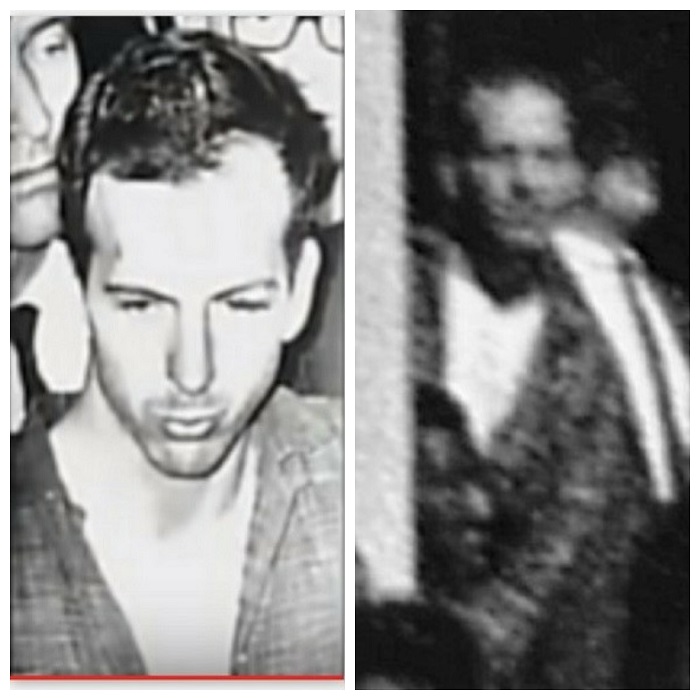
Another good comparison resides below. Note again: matching right collars, left lapels, and V-neck t-shirts. Note also the long neck on each of them. It has to be the same guy.
Here is one final collage, and it happens to be Ralph's favorite. The facial look, the expression, the whole physiognomy, as they say in Medicine, is the same. You can tell that it is the same person peering out at the world. The notion that that degree of likeness of expression and sensibility, as well as physicality, could exist between Oswald and Lovelady is preposteorus. And then when you throw the clothes into the mix, it is just over the top. That is Lee Harvey Oswald on both sides of the image.
We are going to move on now to Billy Lovelady and many reasons why he could not possibly be Doorman. And it's going to be an exciting ride, full of stealth, subterfuge, phony pictures, and phony movies. But before you move on, please gander a little longer at these comparisons of Oswald and Doorman. Do you think there is any chance that Billy Lovelady just happened to wake up that morning and dress himself in the exact same manner as Lee Oswald? Of course not--and it is preposterous to think that he did.
